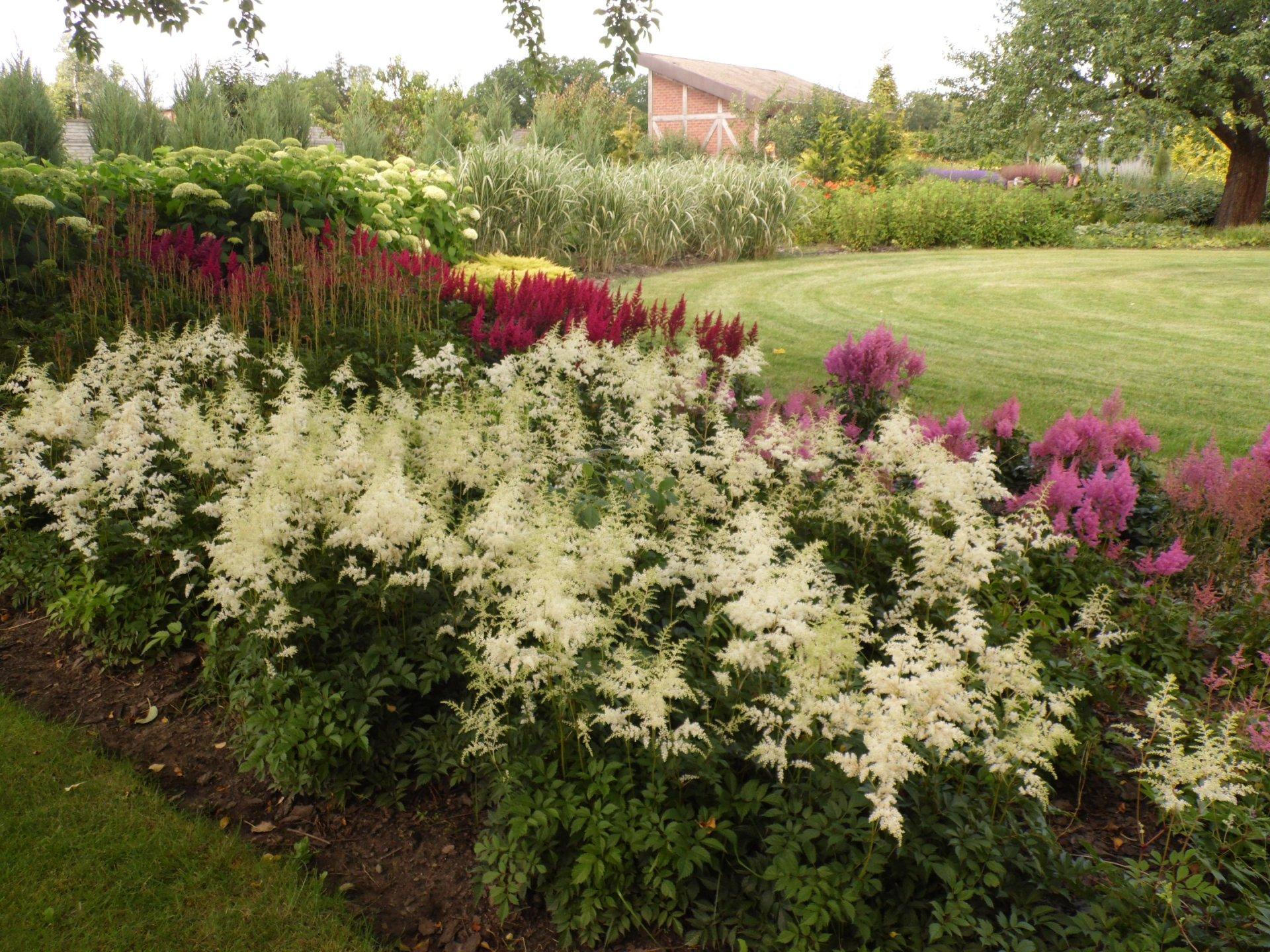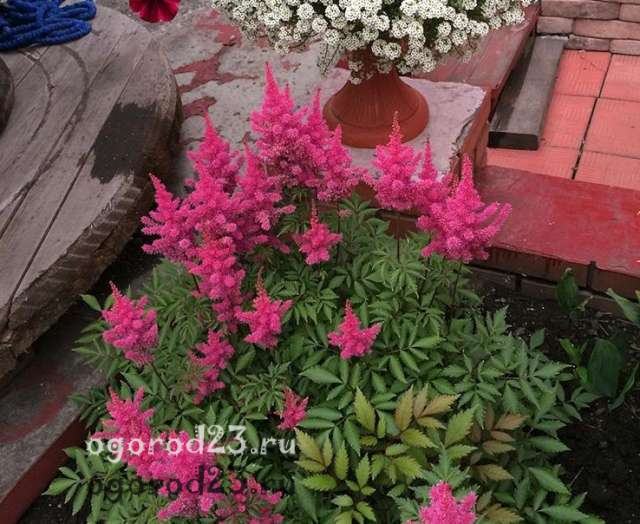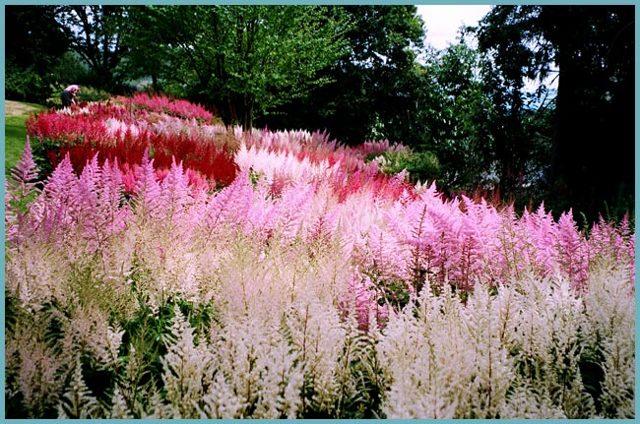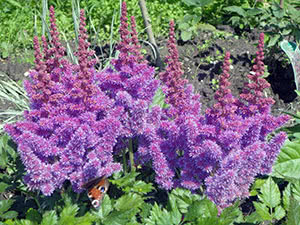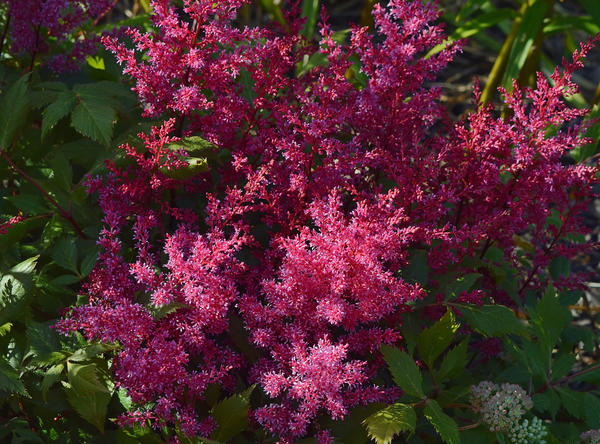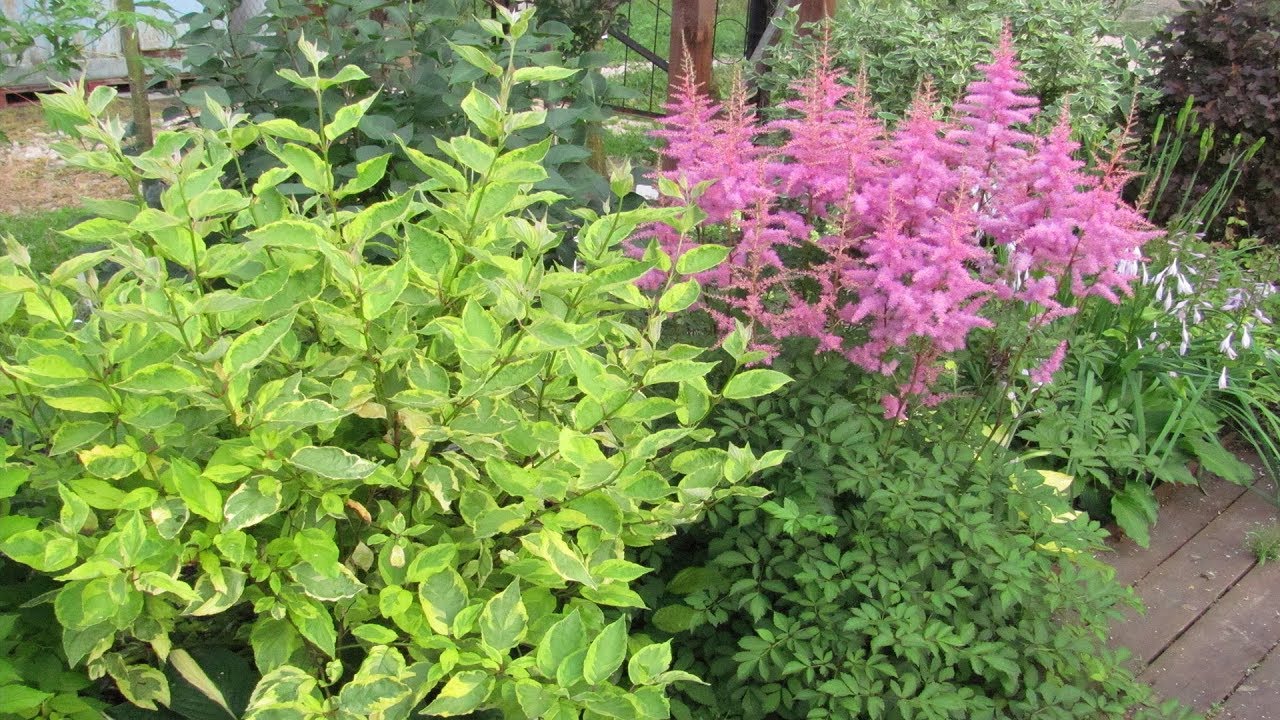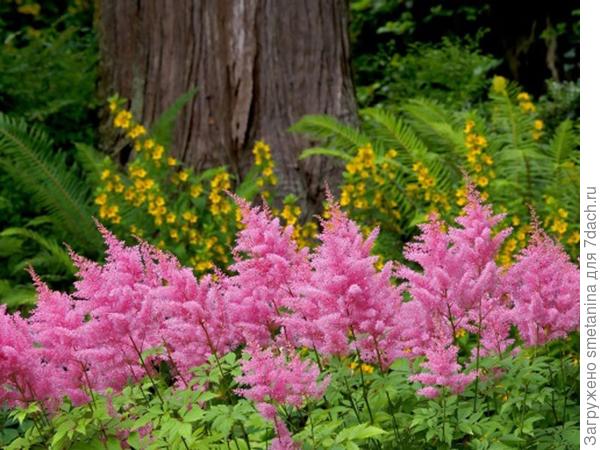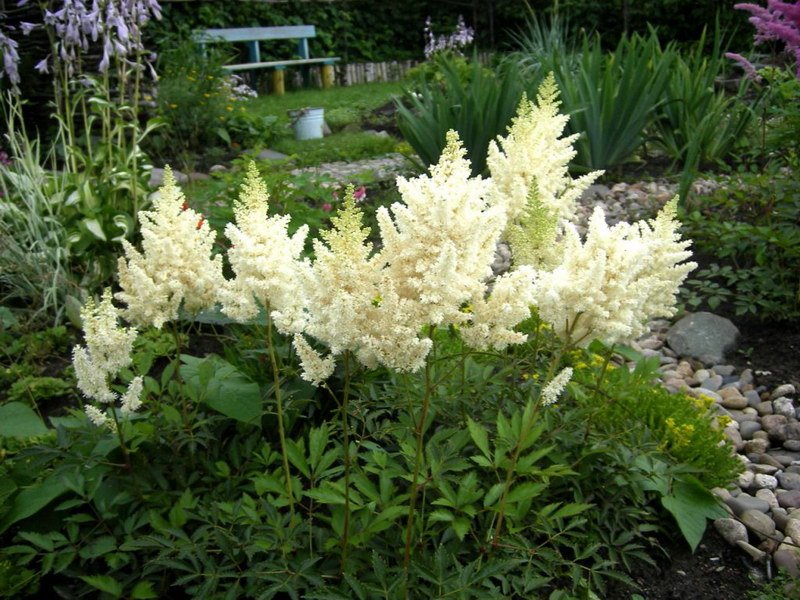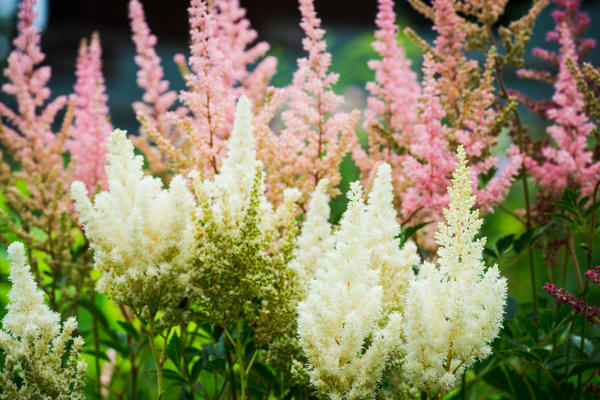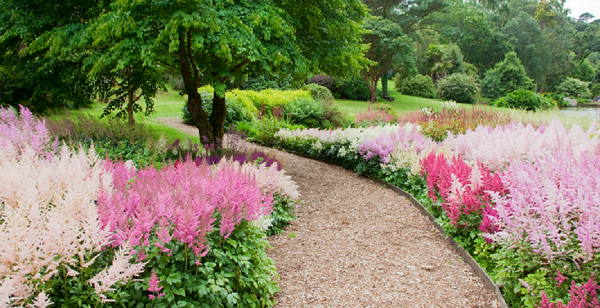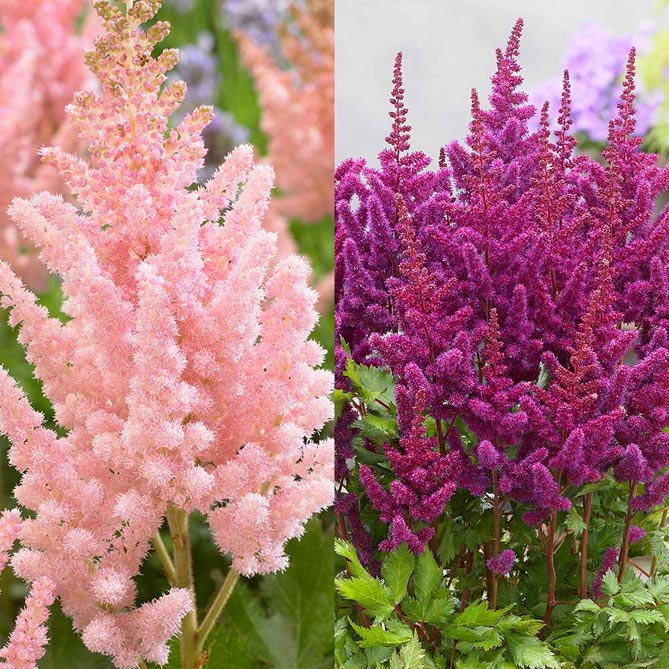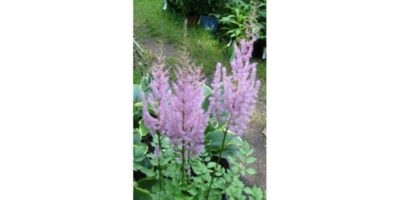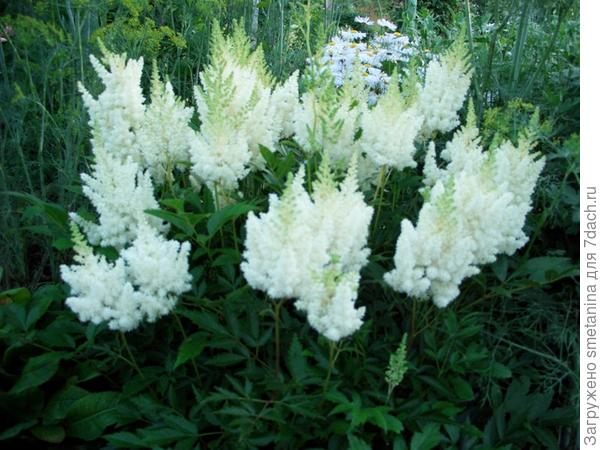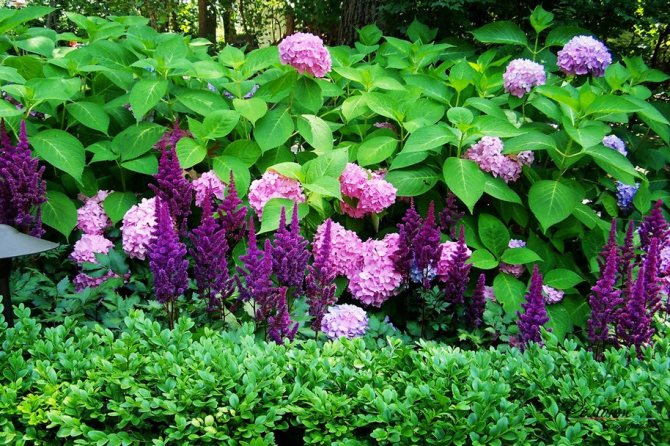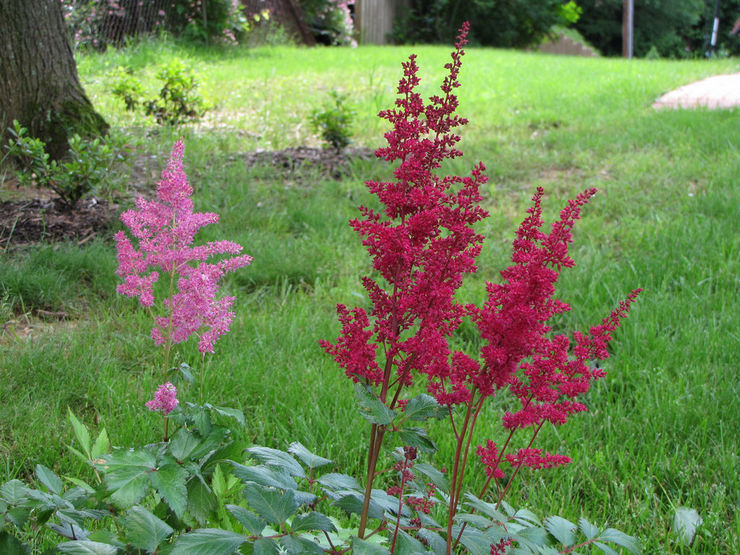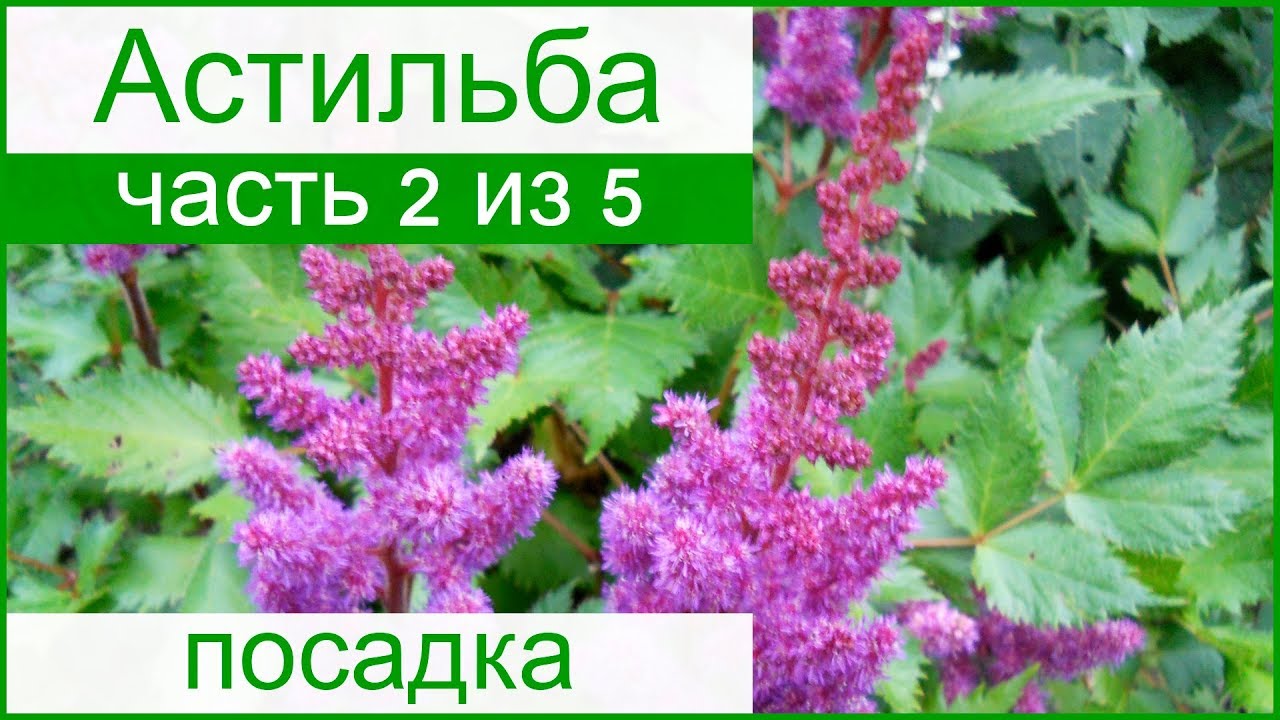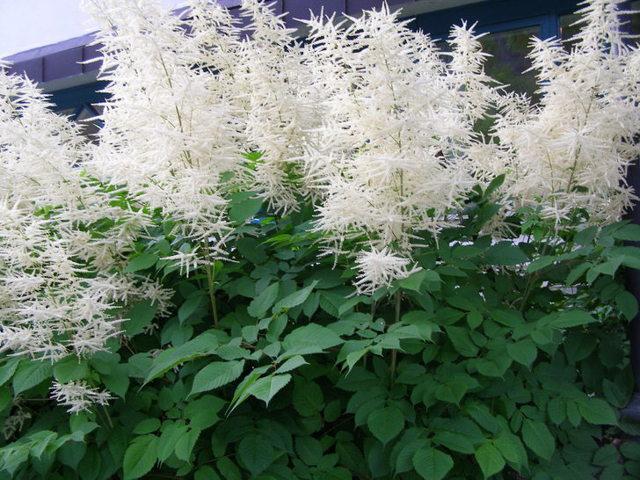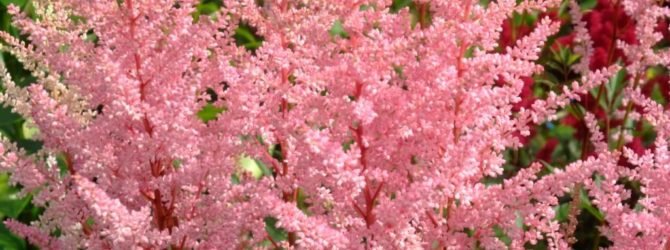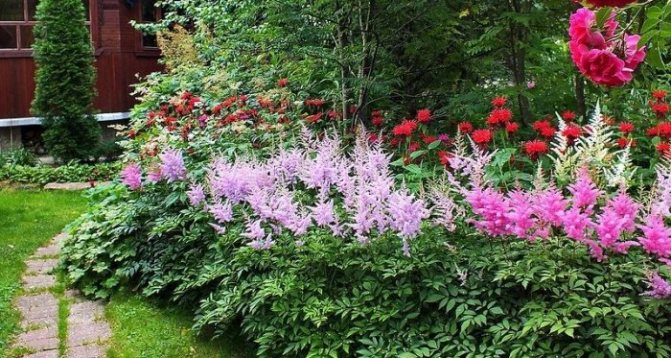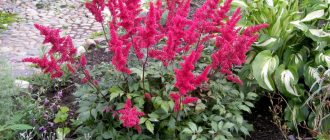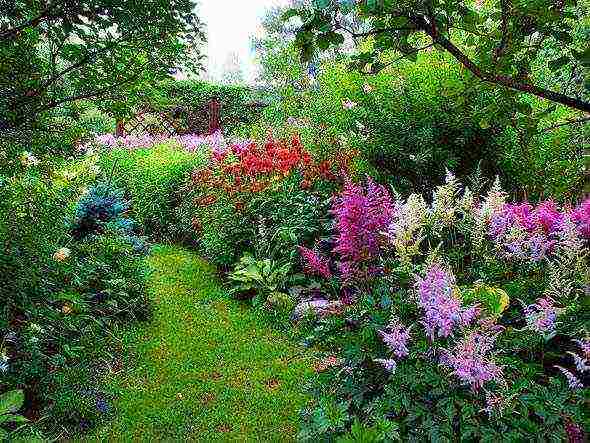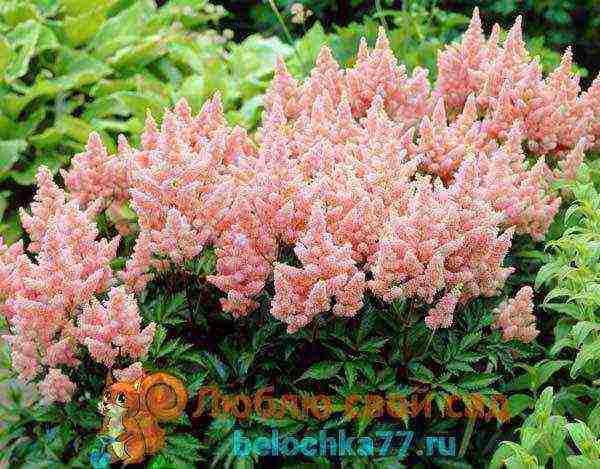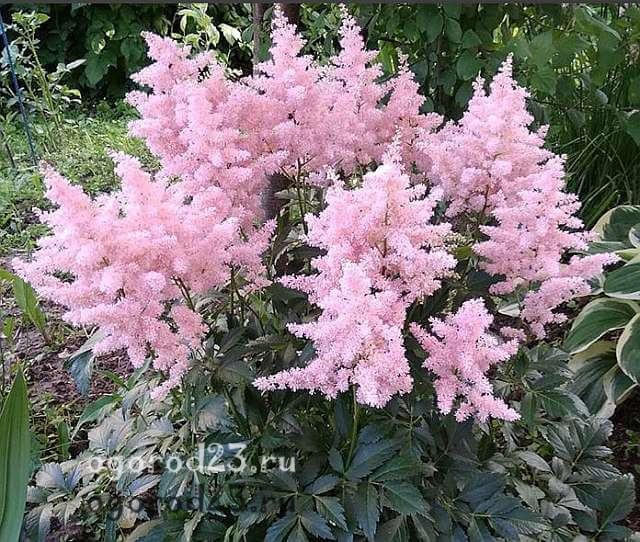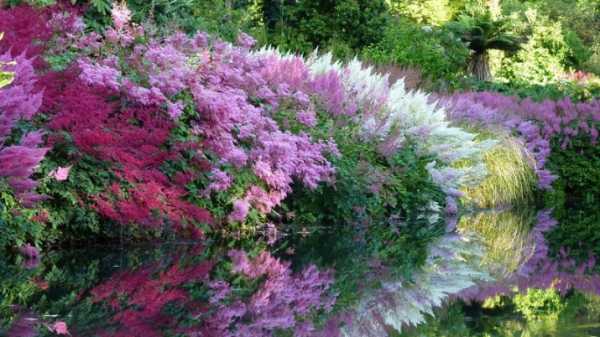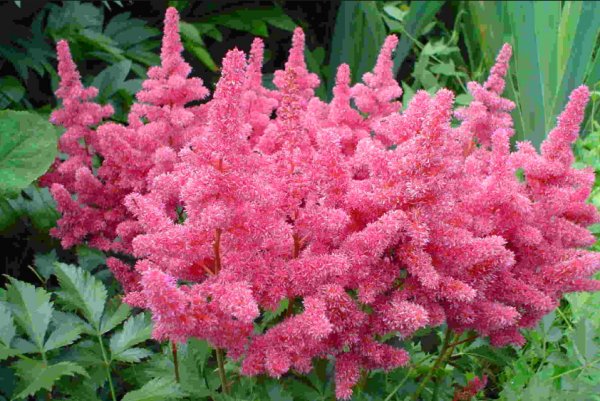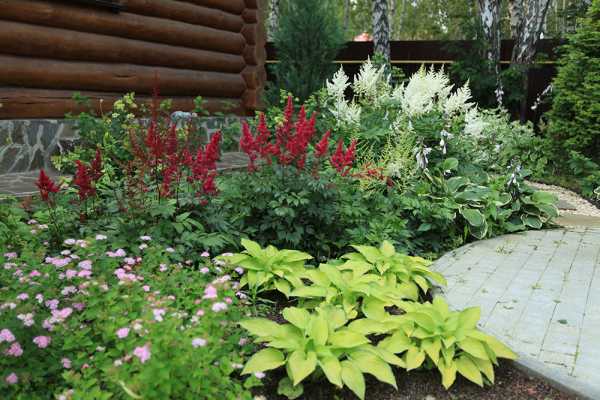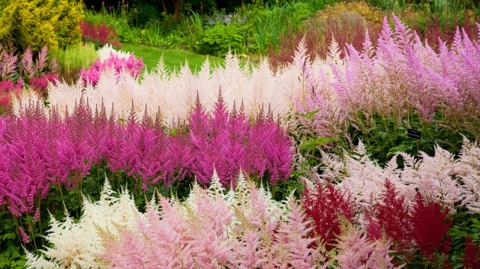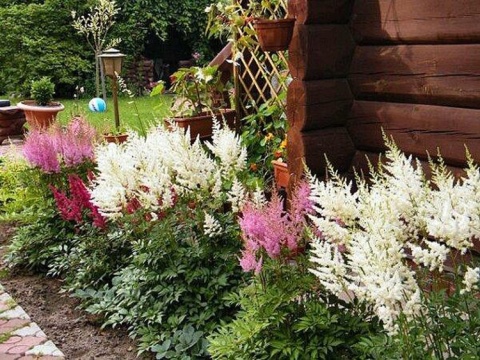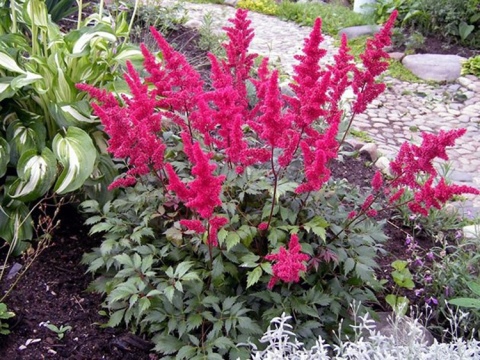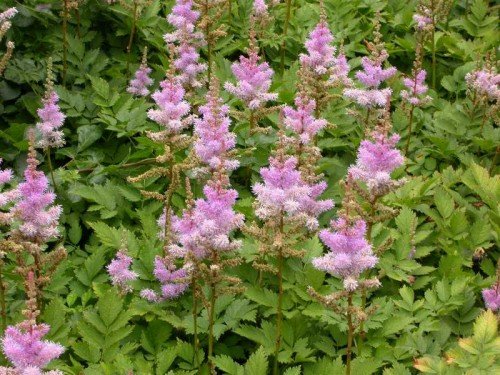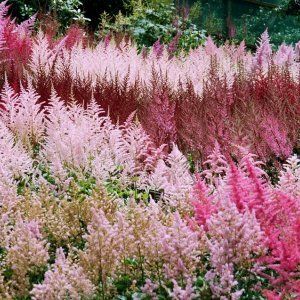Step-by-step instructions and scheme for planting astilba in open ground in the fall
In order to properly plant a herbaceous plant on the site of a private house or in the country, you need to know not only the scheme of the planting itself, but also the features of the preparation. The following step-by-step instructions will help you to do everything correctly.
How to choose a place and soil for planting
One of the important tasks before planting the rhizome of a flower crop is to find the most suitable site for growing. The beauty, splendor, and duration of flowering in a flower bed will depend on how comfortable the plant is in a permanent place.
You need to choose a place in the open ground for planting astilba in the fall according to the following rules:
- The site must be partially shaded. And it shouldn't be some kind of dull shadow, just shading from direct sunlight. Shady areas are especially suitable for mid-flowering varieties that bloom in July. But early and late varieties perfectly tolerate growing in sunny places (however, their flowering period will be shorter).
- The soil on the site should be moisture-absorbing, moist, astilba does not tolerate drying out of the soil (however, Chinese astilba tolerates drying out of the soil better, but even then it is not recommended to allow this). The soil should always be slightly moist, so places with a high groundwater table are well suited.
- Despite the hygrophilous nature of the flower culture, the site should not have stagnant water and excessive moisture, swampiness.
- A place on the north side of the garden or on a flower bed under the openwork shade of trees and bushes is well suited.
- The optimal soil for growing astilba is loose, loamy soil with a slightly acidic reaction (5.5-6.5 pH).
How to prepare the soil and planting hole
General preparation of the site for planting a perennial plant is carried out according to the following scheme:
- First of all, you need to clean the area, remove stones, debris, weed rhizomes (if all this is available in the selected area).
- Then it is recommended to dig up the site (not only where there will be a planting hole, but also around).
- Then, to improve the quality of the soil, it is recommended to add decomposed peat, humus or compost into it (one bucket of each substance per 1 square meter).
- If the soil is neutral or alkaline, you need to make it slightly acidic. To do this, you can use a special acidifier according to the instructions, or add sour high-moor peat (1-1.5 buckets per square meter, depending on the alkalinity of the soil).
- After that, you need to dig up the site again.
- And then loosen and level with a rake.
Prepare landing pit astilbe can be done according to the following algorithm:
- It is necessary to dig a hole, its dimensions should be 2 times the size of the planting material (that is, the rhizome should be freely located in it). The estimated width and depth of the pit is 30 centimeters.
- Distance between planting holes: for tall varieties - 50 centimeters from each other, it is better to plant undersized varieties with an interval of about 30 centimeters.
- Now you need to fill the planting hole with 2/3 fertilizers: humus or compost (1 part) + fertile soil from the top layer (2 parts) + 100 grams of wood ash (half a glass) per hole.
- Mix the fertilizer well in the pit.
- Water.
- Then cover with a thin layer of regular earth.
How to prepare the rhizome
It is recommended to prepare astilbe rhizomes before planting in open ground in the fall. As a pre-planting treatment to eliminate pathogens, you can soak the rhizome in a fungicide solution, for example, "Fitosporin-M", "Maxim Dachnik".
In addition to treatment in a fungicide, soaking in a solution of a growth stimulant, for example "Epin-Extra", "Zircon", can be carried out. Such preparation will improve and accelerate the rooting of perennials in the open field.
Direct landing of astilba
Scheme of planting rhizomes in open ground in the fall:
- It is necessary to slightly untangle the roots of the planting material (if the seedling is with an open root system (ACS).
- Place the rhizome in the center of the hole.
- Cover the seedling with soil evenly.
- In this case, the base of the sprouts of the rhizome should be level with the surface of the earth. If you are planting seedlings of a plant, then you need to plant it at the same depth at which it grew before.
- Then water the plant.
Astilba: what to plant next to
Before deciding what to plant astilba in a flower bed with, it is worth understanding its features and studying the description. This plant is picturesque, bright, has numerous inflorescences. They can decorate a lawn, garden or flower garden. It is grown in Asia, Japan, China, Mongolia. It is also called "false spirea". In the selection of neighboring plants, it also matters, astilba is a shrub or flower.

What does astilba look like
Important! Astilba is loved by many gardeners, so about thirty varieties and species of this plant were bred
What leaves look like
Astilba leaves are complex, bipinnate. Some leaves have a heart-shaped base. They are shiny above and matte below. They look very unusual in bright sun. The foliage can also be rich olive, bronze and burgundy.
What does an astilbe flower look like
The plant belongs to the saxifrage family. The height, depending on the variety, can be from 20 to 200 cm. The flowering time of astilba is from June to September. The flowers thin out the delicate scent that is like bird cherry. The color of the petals can be white, pink, burgundy, red and lilac.
There are several forms of inflorescences:
- Drooping. The inflorescences are on a long and narrow stem. They sink to the ground, which looks especially graceful and sophisticated.
- In the form of a pyramid. The flanks with flowers have a perpendicular divergence to the central axis. These parts become thinner and shorter. The narrowing of the inflorescences occurs from the base to the crown.
- Paniculata. Here, there is also a divergence of the lateral branches perpendicular to the axial, but they also strongly branch
- Rhombic. Branches with flowers grow at right angles and form a kind of rhombus.
Tall varieties
Tall varieties of astilba:
- Amethyst: a bush can grow up to 1 meter in height; the flowers are large, have a blue-violet color;
- Arends: grows up to 160 cm; large pink flowers;
- Pomegranate: grows up to two meters; the flowers are blood red;
- Diamond: grows up to 1.5 meters in height; the flowers are large and white;
- Ostrich feather: grows up to 80 cm; flowers have a lavender hue;
- Thunder and lightning: the height can reach 80 cm; small ruby flowers;
- Lavender: grows up to 1 meter; flowers are small, lavender in color.

Tall variety
A successful combination is obtained with such plants: lilies, daffodils, crocuses, tulips, hosts, junipers, ferns, conifers.
Important! In the first year after the plant has been planted, its leaves do not look very beautiful and luxurious. In this regard, snowdrops, hazel grouses, crocuses are planted nearby.
This is done to fill in the empty space.
Low-growing varieties
The undersized varieties of astilba include:
- Vision in red: height up to 30 cm. Flowers are small, bright purple. They have a strong aroma.
- Gloria: height 50 cm. Lush inflorescences in the form of a diamond. The flowers themselves are small and white.
- Europe: height up to 50 cm. Flowers are pale pink, odorless.
- Montgomery: height up to 70 cm. Flowers are pink and large.
- Purple Rhine: height up to 50 cm. Small purple-pink flowers.
What to plant next to an undersized astilba depends on the season.For example, in the spring it looks good with rhododendrons and iberis. The best combination of this plant is next to daylilies, hosts and incense. A good option is to plant it next to a rose. However, in this case, a certain distance is required.
Planting astilba in the ground
Plant the plant, slightly deepening it so that there is a small hole around. The very point of growth, from where young leaves and peduncles will grow, should be above the soil surface. Compact the soil around the plant and water liberally. At the first time after planting, refrain from feeding, let the young roots go deeper and look for food there.
Planting methods
The main method used when planting astilbe is by transshipment, when the root system is not disturbed, and the plant is carefully moved into the ground to a permanent place.
Optimal planting time
If you have purchased a container-rooted plant, choose the evening time for planting during a warm period. Until the moment of planting, keep the root ball wet, and the plant itself in the shade.
Soil for plants (Composition and selection of soil)
The soil must be fertile and permeable. If there is black soil in the place where you plan to plant, then add some sand and peat to it.
Planting in autumn
Better to plant in the spring or closer to autumn, when the heat is not so strong. Then the plant evaporates not so much moisture and calmly "engages" in rooting.
Planting in the fall is optimal. The plant begins to naturally shed its foliage (sometimes part of the leaves remains until the next year), young seedlings take root, and in adult plants the rudiments of future leaves, inflorescences and young divisions are laid.
Planting in spring
Spring planting is more risky. The weather can change dramatically towards warming - there is a possibility that the plant will be sick from a lack of atmospheric humidity.

Abundant and regular watering will provide optimal soil moisture conditions and a long decorative period.
Weeds should be periodically weeded between the plants. The soil between plants practically does not need loosening, since its surface is covered with foliage and thereby protected from erosion. In order not to form a crust, the plantings can be mulched with chips. This will reduce moisture evaporation and eliminate additional weeding and loosening.
Location and lighting for the plant
Locate Astilba landings in a quiet, wind-protected location. In the open sun, the plant can dry out and burn the foliage. The flowering period in full sun will also be shorter.
Air humidity
Constant humidity will benefit astilbe. In extreme heat drying out the tips of the leaves speaks of dry air. It is preferable to locate landings by a pool, stream, pond, where constant evaporation contributes to an increase in humidity.
How to water properly
Watering should be regular and abundant so that the entire root layer (35-50 cm, depending on the variety) is saturated with water. Drip irrigation, set up so that each plant receives water, is ideal. It is advisable to water with warm water.
Reproduction of astilba
Astilbe reproduces in three ways:
Dividing the bush
The fastest and most effective method, since it allows you to get several full-fledged copies at once in a short period. It is carried out during plant transplantation. The bush is dug up and divided into parts, leaving at least one bud on each. Each plant is planted in a separate hole. Division is carried out in the spring, as soon as the first shoots appear. The place of division is sprinkled with wood ash. A young plant can be divided into 5 years.
Budding (or grafting)
This method can be used if you have a bush that is at least two years old. A small part with one bud should be cut off from the root and planted in a greenhouse or pot.Such a specimen is planted in open ground next spring.
Growing from seeds
Only the seed method is suitable for obtaining new varieties. However, this method is quite complicated, since astilba seeds are small and also have poor germination. To increase germination, seeds are kept for 20 days at temperatures from minus 4 to plus 4. After that, they are placed in a warm place for 2-3 days.
For sowing, take flat containers and fill them with a mixture of sand and peat (1X3). Seeds are laid out on the surface, without dusting, and moistened with a spray bottle. The container is covered with foil and placed in a warm, bright place. The surface should not dry out, otherwise the seeds will die.
The first shoots will appear in 3-4 weeks. The pick is carried out in the phase of the first true leaf. During the procedure, the main root is pinched off by a third to stimulate the growth of new hairs. Each sprout is planted in a separate container. In open ground, seedlings can be moved in the second decade of June.
Astilba flower - growing and care
Lush flowering, shade tolerance, unpretentious care - these are the main advantages of the charming astilba. Her beautiful bush with panicle inflorescences can decorate any area. Let's talk about how to grow it. To do this, you need to understand what requirements the plant makes for its development.
Astilba loves moisture, and can even tolerate slight flooding, but prolonged drought can be disastrous. It is necessary to constantly moisten the soil under it, especially in dry weather. The plant does not belong to acidophilic, therefore, it does not impose special requirements on the acidity of the soil, but prefers more with a PH level of 5.5-6.5.

The root system has an unusual structure, growing, over time, they grow up and appear above the surface of the earth. Because of this, in frosty winters, the bush can freeze, and in summer it dries up quickly. In depth, the root system does not grow deeper than 20-25 cm, because of this it cannot get moisture from the deep layers of the soil. Therefore, one of the best recommendations is to mulch the soil around the trunk well, this will help retain moisture in the summer, and will provide additional insulation in winter.
Astilba loves fertile soil. Therefore, in the spring, as well as in the first half of summer, the plant must be fed twice with mullein infusion or mineral nitrogen-containing fertilizers after watering or rain. A good result is given by monthly fertilizing with vermicompost.
Inflorescences, after their flowering, it is recommended to cut them off so that the plants do not waste energy on planting seeds, if you do not plan to collect them. And the plant itself is recommended to be fed with phosphorus-potassium fertilizers, this will increase the winter hardiness of the plants. Astilba propagates by seeds or by dividing the bush. The division must be carried out every 4-5 years, otherwise the middle of the plant will die off. The best time for this is early spring or already in August.
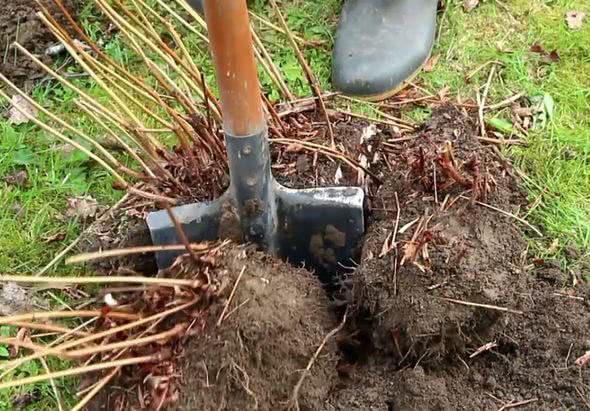
When dividing, the bush is dug out, then cut into slices with a sharp shovel or knife so that each has from 1 to 5 buds of renewal. Delenki are planted right away so that the roots do not have time to dry out. At the same time, they are planted shallow, but the distance between them should be at least 40-50 cm, since the bushes grow rather quickly. At the same time, humus or compost is laid in the planting holes, and half a glass of ash and 1-2 tablespoons of superphosphate are added. After planting, be sure to watered abundantly.
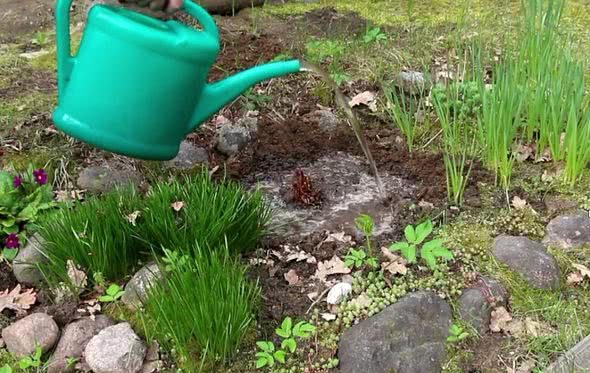
The aboveground part of the plant dies off in autumn, and each spring, shoots from the roots begin to grow. Therefore, the astilba is cut off after the onset of the first frost almost to the root and covered with a layer of mulch 5-10 cm thick on top. High moor peat, rotted manure, humus are used as mulch.
Astilba: planting and care outdoors in Siberia
Outstanding feature of this perennial shrub is that the growing season will not be stable at temperatures below 10 ° C.Due to the harsh weather conditions of Siberia compared to the western climate, astilbe can only wake up in late spring or early summer. At this time, transplanting, planting and sowing are performed here.
Note! Skilled growers also practice autumn or August planting. The plant must be planted so that it has time to adapt and form a stable root system within a month before the onset of frost
In Siberia, as early as in autumn, mulching begins, for which sawdust and crushed tree bark are used. The flower propagates mainly by dividing the bush. Watering, feeding, pruning and covering are carried out identically to other regions.
Astilba saxifrage, which beautifies nature, when taken care of in the garden, gives it a luxurious and impressive appearance. The plant does not like a lot of sunlight and requires an abundant amount of water, but it is unassuming to care for, and the compositions created from it can compete with architectural ensembles. Due to the peculiarities of its life, astilbe grows in the East, Asia, Europe, North America and even in the Far North.
How to plant
Planting astilba in a garden or in a vegetable garden will not be a difficult process. The perennial is unpretentious, tolerates frost well and rarely gets sick. It's easy to look after him.
It is unacceptable to deepen the bush and cover the growing point with soil. At the bottom of the pits, you can place a hydrogel, taking care of the preservation of soil moisture. And also for this purpose ash with bone meal and fertilizers with minerals are suitable - one matchbox in a dosage.
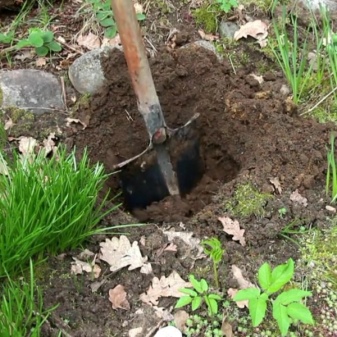

In the surface layer of the soil, the content of phosphorus and potassium in the right amount is important. For good reproduction, the soil in the beds should be treated with complex fertilizers and a couple of handfuls of bone meal
The flower garden should be properly planted in holes no deeper than 30 cm, where the above-mentioned baits with flour and humus are poured. All ingredients are mixed and filled with water. Delenki are covered with a 3-centimeter layer of mulch.
It is allowed to mulch the soil surface with any peat crumb, which makes it possible to keep the soil uniformly moist and prevent the root system from drying out in the future.
Seed propagation
To preserve the decorative and varietal characteristics of astilba, it is rarely propagated by seeds. If seeds were used for cultivation, perennials show inconsistency with the declared varietal characteristics. The brushes on such plants are low decorative in appearance, the color is atypical, the flowers are sparse, and their flowering period is unusually short. For seed propagation, only high quality seeds of varietal selection should be used.
Seeds are sown in moist soil and are not covered
To speed up the germination process, it is important to maintain high humidity (as an option, crops are placed under glass, or kept in a greenhouse). Further, the process of growing seedlings consists of watering the seedlings
It must be timely, preventing overdrying of young plants. And also the sprouts must be protected from direct sunlight, but plant them in a bright place.
Good germination performance is achievable with seedling stratification. For 21 days, seeds are poisoned to be hardened in a cold place (from +4 to - 4 ° C). Then they are sown already in the greenhouse and at t + 20 ° C. After a couple of months, young shoots are to be transplanted into open ground. Seedlings from hardened seeds are distinguished by high survival rate and growth rates.
By dividing
This method is called vegetative and is considered traditional and the most reliable among flower growers.
Carefully dig up the mother plant to maintain the integrity of the sensitive rhizome. Using a sharp blade, carefully divide the rhizome into several segments with 2-3 buds
Sprinkle crushed charcoal over the slices.
In a previously prepared furrow, at some distance from each other, spread the planting material, and moisten the soil. Obvious results when planting divisions are achieved on root formation stimulants. The process of caring for sprouts consists of regular watering and loosening of the soil.
Planting of cuttings is carried out from early spring, starting in March. The described breeding method involves the flowering of astilba with the arrival of autumn.
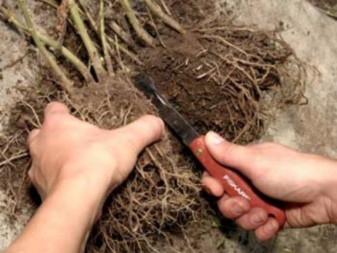
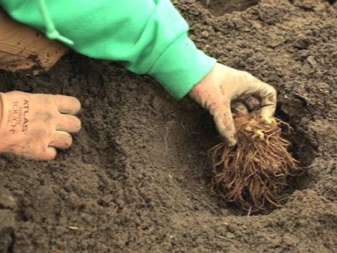
By kidneys
You can quickly propagate a perennial plant in the spring, using division by buds. Use a sharp blade to separate the areas with renewal buds. Plant the cuttings in a greenhouse with moistened soil, mixed with sand (coarse) or gravel, and cuts sprinkled with ash in advance. This method of propagation marks the excellent survival rate of fresh shoots. The only drawback is that it is necessary to wait about a year for a full-fledged plant.
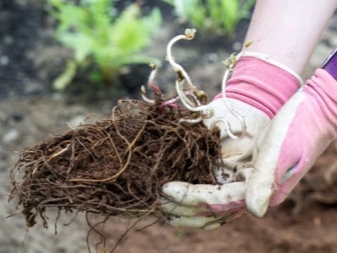
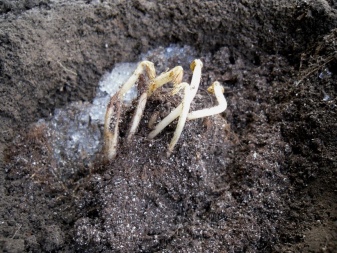
Astilba is attractive not only by its decorativeness, but also by the fact that it is practically not susceptible to attack by pests and diseases. The root system of some crops is rarely affected by rootworm nematodes. These small pests are not afraid of antiparasitic drugs, therefore, in order to exterminate it, you have to destroy the infected bushes. Moreover, part of the soil in contact with the roots of the diseased plant is also subject to removal. It is undesirable to plant plants at the site of infection for several years.
Another parasite that threatens death is the drooling penny. Infected astilba slows down leaf development. The method of prevention can only be the collection of insects from the leaves of the bush by hand.

